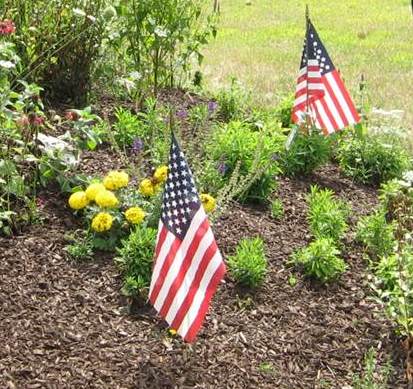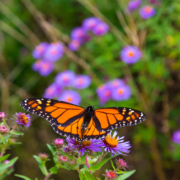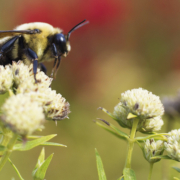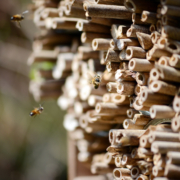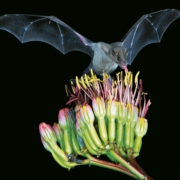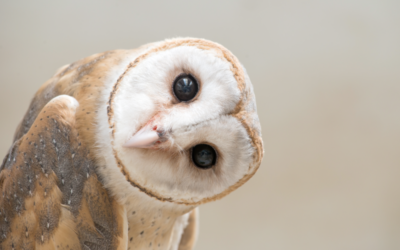Celebrate Independence Day the Wildlife Way
Here’s an idea for a fun Fourth of July activity: plant a patriotic pollinator garden! Many pollinator-friendly plants have red, white, or blue blooms, berries, stems, or leaves. (Click here for a list of red, white and blue plants.) Already have a pollinator garden? Even if it doesn’t have a red, white, and blue theme, you can still use it to celebrate the Fourth of July. Bayer Corporation’s Pittsburgh Site (a 2008 Signature of Sustainability) has multiple pollinator gardens along their nature trail. Each year during the week before July 4th, employees are invited to place small American flags on the garden mounds in recognition of our service members. Tags with the names of family members, friends, or neighbors who are serving or have served in the armed forces are attached to each flag.
What better way to celebrate the United States’ birthday than protecting its national symbol? The bald eagle (Haliaeetus leucocephalus) is an All-American eagle: it is the only eagle species unique to North America. Although populations remain below historic levels, the species has made a significant recovery since over-hunting, contamination, and habitat loss reduced populations to endangered levels (fewer than 500 breeding pairs) in the 1960s. Conservation efforts have allowed bald eagle populations to rebound to more than 5,000 breeding pairs. The major breeding populations are in Alaska and Canada, but significant bald eagle populations occur around the Great Lakes, in Florida, the Pacific Northwest, the Greater Yellowstone area, and the Chesapeake Bay region. Bald eagles are large fish-eating birds of prey, but will also eat smaller birds, turtles, and carrion.
 What can you do to help the bald eagle? Protect large trees in mature stands located within half a mile of bodies of water such as rivers, lakes, or bays. This is especially in the parts of North America where bald eagles breed from early spring through late summer. Improving aquatic habitat with structural enhancements and native vegetative buffers will help populations of fish, waterfowl, and shorebirds, which in turn will provide food for bald eagles. Of course, nesting bald eagles should never be disturbed.
What can you do to help the bald eagle? Protect large trees in mature stands located within half a mile of bodies of water such as rivers, lakes, or bays. This is especially in the parts of North America where bald eagles breed from early spring through late summer. Improving aquatic habitat with structural enhancements and native vegetative buffers will help populations of fish, waterfowl, and shorebirds, which in turn will provide food for bald eagles. Of course, nesting bald eagles should never be disturbed.
For our friends north of the border, independence is celebrated on July 1, Canada Day. Patriotic pollinator gardens can include plants from the list above with red or white flowers, berries, or foliage. Another patriotic planting can include the maple tree, a major symbol of Canada. Maples provide shelter and food for numerous species of wildlife. Many moth species lay their eggs on maples, making them a pollinator-friendly group of trees.
The American beaver (Castor canadensis) is another well-known symbol of Canada. It is the largest rodent in North America and occurs across most of the continent. Before the start of the fur trade, Canada’s beaver population was estimated at six million. As a result of the fur trade, beaver populations experienced a major decline and nearly became extinct in the 1800s. Beaver populations have rebounded since then due to the declining demand for fur hats in Europe.
Beavers often build dams to ensure that the water level around their lodges remains relatively constant. This is also beneficial to other wildlife species. Waterfowl benefit from the increased habitat created by beaver activity. Other species of birds that benefit include great-blue herons, ospreys, eagles, and kingfishers, as well as numerous species of songbirds. Mammals such as otters, minks, muskrats, deer, and black bears all benefit from the increase in foraging habitats that are a result of beaver activity. Numerous species of fish also benefit from beaver activity, including bass, trout, pike, and salmon. Beavers will eat water lily tubers and the leaves and green bark from aspen and willow trees; conserving wetlands and maintaining these species can help support beaver populations. Information about beaver management, including nuisance beavers, can be found in the Wetland Mammals Management Leaflet.
